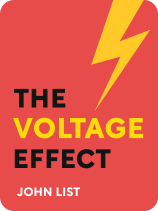

This article is an excerpt from the Shortform book guide to "The Voltage Effect" by John A. List. Shortform has the world's best summaries and analyses of books you should be reading.
Like this article? Sign up for a free trial here.
As your organization grows, how can you maintain your culture? How should your teams be organized, and what should they prioritize?
The Voltage Effect by John A. List is an economics text designed to help you understand the characteristics of scalable ideas. He argues that you should focus on building a sustainable culture while you scale your ideas.
Read more to learn how to scale culture by embracing collaboration and diversity.
How to Scale Culture
As your organization grows, collaboration becomes increasingly important. When an organization is in its infancy, the drive, talent, and ideas of one or two individuals may be enough to propel it forward. However, as we know, talented individuals don’t scale. Instead, as your organization grows, you must scale culture along the way, as success will depend on clear and efficient communication within a larger group of employees.
To incentivize teamwork, List suggests assigning each employee to multiple teams, which will help ensure that ideas are shared across your organization and help employees invest in the success of the organization as a whole.
| Learning to Collaborate at Scale Experts note that collaboration often comes naturally to small businesses in their early years, but as they scale, these businesses often struggle to continue collaborating. At young companies, there are usually fewer employees who work together more closely than at larger organizations. These employees tend to form strong bonds that enable them to collaborate informally and effectively. However, as an organization grows, it becomes impossible for each member of a team to build a deep relationship with everyone else. Because of this, as your organization scales, you’ll have to implement policies that lay the groundwork for effective collaboration. To set your organization up to cooperate efficiently at scale, Matthew Skelton and Manuel Pais recommend, in Team Topologies, that you assign staff to smaller teams and provide guidelines for how teams should interact and communicate with each other. And, as Patrick Lencioni argues in The Five Dysfunctions of a Team, you can financially incentivize teamwork by offering bonuses based on the teamwork output. |
Along with collaboration, diversity helps organizations to succeed at scale. Diversity enables your organization to solve problems creatively, as individuals from a variety of backgrounds will naturally bring a variety of perspectives, ideas, and problem-solving tools to their work.
(Shortform note: Diversity can also help boost employee retention. Studies have shown that in addition to the benefits List describes, cultivating diversity can also help your organization keep its best employees. Over time, as those employees continue to innovate and excel within your firm, the strength of your workforce may become a competitive advantage for your organization.)
List argues that you must demonstrate a real commitment to diversity to recruit a diverse workforce. Specifically, List notes that diversity statements fail to attract many candidates when they’re not paired with policy and action. However, when organizations commit to hiring candidates from minority groups and simultaneously commit to treating employees well and fairly regardless of their backgrounds, word gets around, which leads more strong minority candidates to apply.
(Shortform note: As part of your efforts to create a positive environment for a diverse workforce, experts recommend educating your current workforce on workplace diversity. To keep the diverse range of employees you hire, education can help ensure that your current staff welcomes all new hires and treats them with fairness and respect. Without educating your staff, you run the risk of mistreating and alienating your new hires, which may ultimately cause them to leave your organization.)

———End of Preview———
Like what you just read? Read the rest of the world's best book summary and analysis of John A. List's "The Voltage Effect" at Shortform.
Here's what you'll find in our full The Voltage Effect summary:
- How to take ideas from the small scale to the big stage
- The red flags that signal you may have trouble scaling up
- Strategies designed to increase your idea’s chances of success






